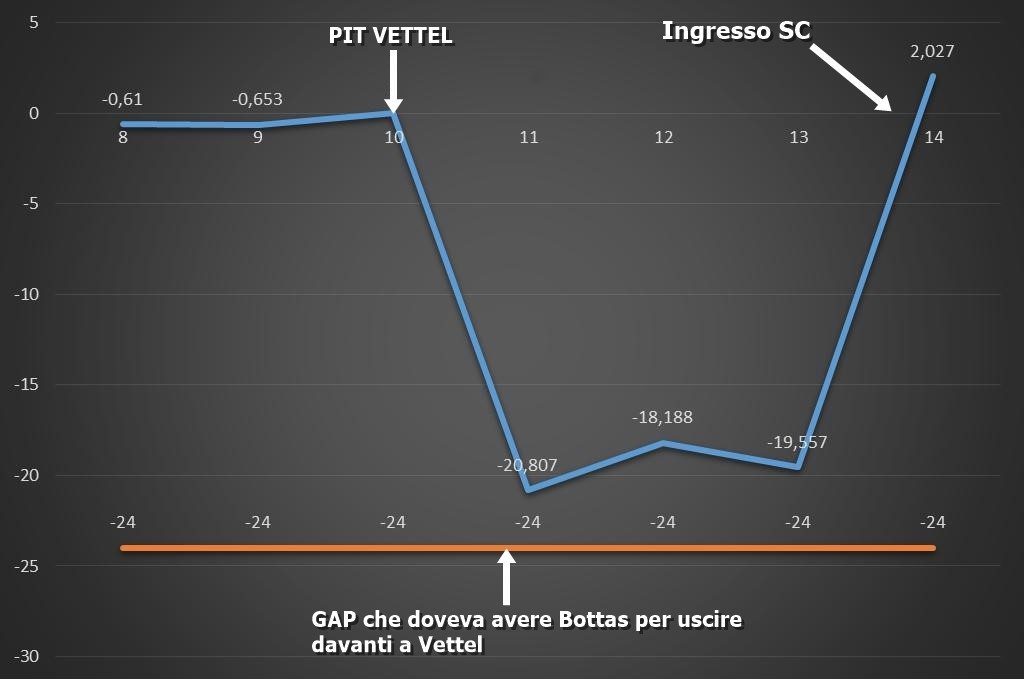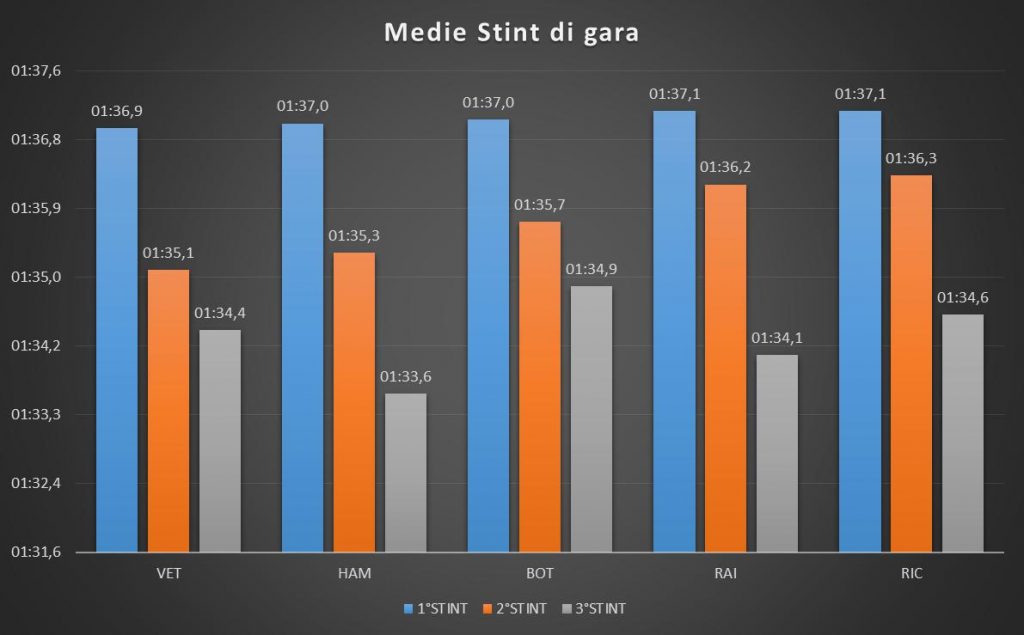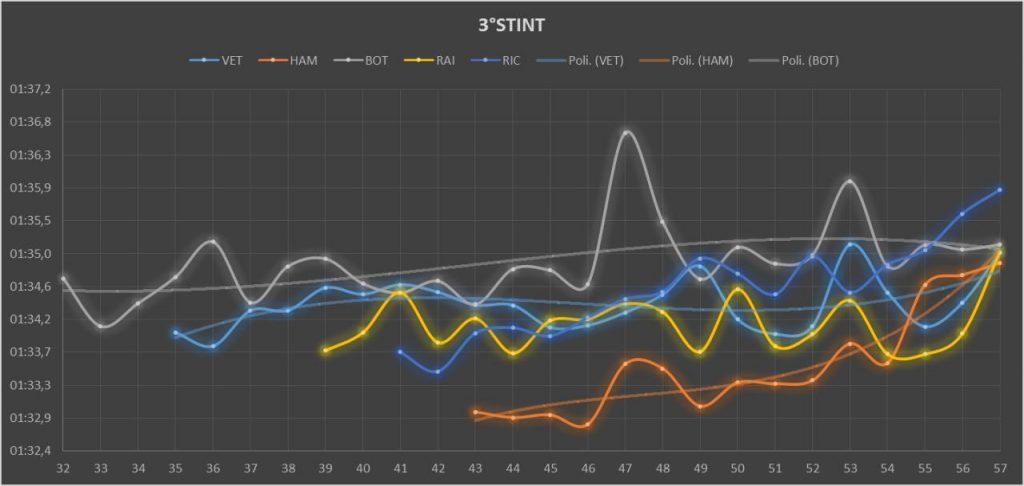Written by @spontonc e @smilextech – Translated by Federico Marchi
The Ferrari SF70H “reborns” on Easter after a disappointing qualifying on Saturday. Disappointing not for the position on the grid, the minimum result that Vettel is expected to achieve, but mainly for the gap from the pole man Valtteri Bottas. Gap that increased due to an improper use of the electric engine MGU-K (resulting in a lose of important time mainly in the earlier meters of the straights), back then on Sunday at its standard levels.
The setup chosen by the whole team together with his main driver, the four times world champion Sebastian Vettel, turned out to be perfectly spot on during the race with another (the third) optimal management of the 2017 tyres (mainly on Supersofts but also on Softs). It is using the first compound, Low Working Range and thus requiring lower temperatures than the yellow one, that the SF70H partially made the difference with respect to the good, but not excellent, Mercedes W08.
Since the start, the race went immediately on the right track for Sebastian Vettel. It was fundamental for the German driver to pass at least one of the two Silver Arrows. And so it was thanks to a great move (and to an asleep Hamilton). Since the earliest laps it was clear that Bottas did not have the pace to create a gap on the rivals, primarily Vettel and his SF70H that managed to keep a gap lower than 1 second and were able to put pressure on the W08. But there is a technical explanation to this: because of a failure in the power generator next to the grid slot of Valtteri Bottas, the Finnish driver started the race with significantly higher pressures than those imposed by Pirelli. What was the consequence? An even greater increase in the pressure while the tyres were reaching the correct temperature, resulting in a lose of grip in the rear of the W08. Valtteri Bottas therefore closed off the drivers behind him, favoring in this way also the RedBull’s couple (who showed in the first part of the race a good pace on SuperSofts). The explanation is easily given: the RB13 is a car that struggles to bring tyres quickly to the right temperature (in the proper window of functioning). This allows a better use of the Low Working Range compounds with respect to the High Working Range ones (for instance the Soft tyres). Recalling the Chinese Grand Prix, we see that both RedBulls used only SuperSoft tyres, because of the difficulty, giving the bad weather in Shanghai, in reaching the right temperature with the other types of tyres. This is so, the exact contrary of what happens to the Mercedes W08, that instead tends to overheat the Low Working Range compounds and to use quite well the High ones. Coming back to the start, if we can say that Vettel took advantage from the above explained situation, the same is not true for Kimi Raikkonen that, in the attempt to get ahead of Ricciardo, was overtook by Massa. The initial move of Felipe will cost precious seconds to the SF70H of the Finnish driver in the development of the race, unable to get for the third consecutive time a place on the podium.
Lap 10 has been decisive: Ferrari’s box decides to try an undercut on Bottas (an aggressive strategy that can lead to some problems as happened in China, or that can help in passing the driver ahead as happened in this case). Mercedes did not react, while RedBull matched Ferrari’s strategy the lap after (upon request of Verstappen). Choice that turned out to be correct, given that Vettel on SuperSofts was substantially quicker than his competitors and that the Bahrain’s circuit is a track that allows to overtake quite easily, mainly if tyres ensure better performance in traction with respect to the driver ahead.
But as already happened in China, also in Bahrain the right and aggressive strategy of the Men in Red has been almost “ruined” by the Safety Car deployed during lap 14 because of the crash between Stroll and Sainz. As you can observe in the graph below, the possibility that Bottas came back to the track after his Pit Stop ahead of Vettel has never been questioned but the Safety Car could have definitely messed up Ferrari’s plans because Vettel was forced to drive for more meters than Bottas at a much lower speed. Mercedes took advantage from the deployment of the Safety Car to pit both cars but in that phase of the race two facts partially conditioned the rest of the race: first, Bottas in fact had the possibility to substitute his tyres and come back ahead of Vettel but because of an electric issue occurred to the tyre guns and then due to the time he had to wait to allow the passage of Ricciardo near his pit slot, the Finnish driver lost 4 seconds. Crucial seconds that forced him to enter the track behind Vettel with a gap slightly higher than 2 seconds. Second, Hamilton won the award for the idiocy of the day (the third of the weekend after having missed the pole position for an oversteer near turn 10 and for a DRS problem that costed him almost 2 tenths) receiving from the race direction, a 5 seconds penalty to have slowed down Ricciardo at the Pit Lane entry. At the restart, Vettel made another miracle given that with an amazing move managed to keep Bottas behind him.
The most disadvantaged driver from the deployment of the Safety Car has been for sure Kimi Raikkonen that did his Pit Stop during Lap 13 and did not manage to unleash the potential of his SuperSoft tyres.
Average of the race stints
1st STINT
In the first race stint the pace of the four top drivers has been influenced by Bottas, who, because of tyres’ problems, had a slow pace. The increase in the pressure of the tyres caused an excessive slip of the W08 with consequent overheating of the rear tyres. The tendency line of Bottas shows that the times of the Finnish driver suddenly increased unlike those of Vettel and Hamilton.
Vettel’s pace, instead, although impeded by Bottas, has been quite good. Even if he constantly raced in the wake of Valtteri, his tyres did not struggle. The management of tyres, mostly the Low Working Range ones, seems to be the greater advantage of the Italian team on the German one in this 2017.
2nd STINT
In this part of the race the leading drivers used different compounds:
- Vettel and Bottas – new SuperSofts
- Hamilton and Ricciardo – new Softs
- Raikkonen – used SuperSofts
The already encountered problems on Bottas’ W08 with the red compound, occurred, even if in a less evident way, also during this 2nd stint proving once again that the Mercedes W08 has not yet fully understood this type of tyres. The driver number 77 has been able to put pressure on Vettel only in the first corners after the restart. Later, Vettel increased quite easily the gap, while Bottas gradually lost performance over time. These issues forced the box to ask Bottas to let his teammate through given that on Soft tyres he was having a very good pace.
Vettel, in this 2nd stint, was the fastest driver on track. The SF70H on red tyres has been quick and constant with respect to the other drivers who were on the same compound. Looking at the tendency line it is possible to infer that the Softs were definitely the better choice on the distance. We simply see this by looking at the times and tendency line of Hamilton that, on Soft tyres, has been able to have a better pace of Vettel of two tenths (even if the stint of the English driver has been substantially longer). A Mercedes W08 that seemed to have completely understood the problems occurred in Australia, at least for what concerns the High Working Range compounds.
Soft tyres that, instead, caused problems to Ricciardo and his RB13. It was quite clear since the earliest laps that the Australian driver did not have the correct temperature on his tyres, thing that made him feel like driving on “ice”.
Not good the pace of Raikkonen that, due to the fact that he was on used tyres and because of a bit of traffic, was on average 1 second slower than his teammate.
3rd STINT
In the last part of the race, with the same compound, the fastest driver was Hamilton. He, in fact, has been able to have a better pace than his main competitor (Vettel) of almost 8 tenths. The English driver, by trying to reduce the gap from Ferrari, pushed very hard, while Vettel was simply managing the race. For this reason, as happened in China, it is very difficult to make a comparison between the two performances. The German driver for sure, also by looking at the pace of Raikkonen, could have done better but to be honest he did not need it.
If we analyze the tendency line of Hamilton and we compare it with that of the 2nd stint we see that the times increased more rapidly. Not so good the pace of Bottas on this compound. Unlike his teammate, he proved to be not so competitive with nearly every type of tyres, demonstrating that he has not yet fully understood the management of these new tyres.
In the end we can say that Ferrari leaves Bahrain in a very good shape, conscious to have a car that, during the race, is competitive on every track and in every condition. The easiness with which the SF70H and Sebastian Vettel manage the 2017 tyres is clear even if over time, being always behind in Quali can make the difference. If Ferrari can make that little (in Bahrain seemed to be big) step forward on Saturday then also the management of races would turn out to be easier. This because, as already said, always adopting aggressive strategies can over time lead to a series of potential failures (as for instance in China, with the deployment of the Safety Car). For what concerns Mercedes we have to say that the German team, even if they did not bring new updates on track with respect to the first race (only a strengthened bottom), on the race pace got closer to Ferrari that ruled on every aspect in Melbourne. The German team is progressively understanding the 2017 car but it is not yet sufficient, mainly if his first driver, in this case Lewis Hamilton, makes so many errors as in Bahrain. Mercedes know this: they must always have perfect weekends to beat this Ferrari and Sebastian Vettel.







